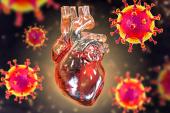Lingering Symptoms After COVID-19 Tied to Heart, Lung, and Kidney Injury
“Long COVID does have a pathological basis to it,” Colin Berry says.

Patients hospitalized with COVID-19 have objective evidence of damage to multiple organ systems up to 2 months after discharge, and these abnormalities have a relationship to persistent—or “long COVID”—symptoms, a prospective study demonstrates.
Imaging, ECG, and biomarker tests performed 28 to 60 days after patients left the hospital revealed injuries to the heart, lung, and kidney that were not seen—or not observed as frequently—in contemporary controls without COVID-19, Andrew Morrow, MBChB (British Heart Foundation Glasgow Cardiovascular Research Centre, University of Glasgow, Scotland), and colleagues report in a study published earlier this week in Nature Medicine.
Patients with COVID-19 also had worse health-related quality of life, more anxiety and depression symptoms, and poorer exercise capacity, as well as an increased need for outpatient care over longer-term follow-up.
“COVID-19 is a multisystem illness,” senior author Colin Berry, MBChB, PhD (British Heart Foundation Glasgow Cardiovascular Research Centre, University of Glasgow), told TCTMD, adding that the study indicates “long COVID does have a pathological basis to it.”
By preventing serious cases of COVID-19, vaccination can help prevent long COVID symptoms, Berry stated, citing data from the UK Office for National Statistics. Underscoring the importance of vaccination, he added that “fit and healthy and well individuals should take cognizance of the fact that COVID-19 can very much lead to the most-severe forms of illness in them. This is not an illness that is restricted to the elderly, the infirm, and those with preexisting disease.”
Tying It All Together
Although numerous prior studies have shown that symptoms like fatigue, breathlessness, and exercise intolerance can plague patients for months after recovering from acute COVID-19, there is a dearth of evidence connecting that phenomenon—called either long COVID or postacute sequelae of SARS-CoV-2 infection (PASC)—with objective evidence of disease.
The current analysis, Berry said, ties it all together through the use of multisystem imaging and other testing, the tracking of clinical outcomes in a prospective fashion, and comparisons with contemporary controls—all designed to minimize biases seen in other studies. At three hospitals in Scotland, investigators tested blood biomarkers, performed ECG, and evaluated patient-reported outcomes both when patients were initially hospitalized with COVID-19 and 28 to 60 days after discharge. At that later time point, they also performed chest CT with pulmonary and coronary angiography and cardiorenal MRI. Information on longer-term clinical outcomes was collected via electronic medical records.
The analysis included 159 patients hospitalized with COVID-19 (mean age 55; 43% women) and 29 controls who underwent the follow-up evaluations between May 2020 and March 2021. The cohort was largely unvaccinated, as only two patients each had received a single dose of COVID-19 vaccine.
In the patients who had been diagnosed with COVID-19, the postdischarge evaluations showed frequent CT chest abnormalities and MRI evidence of myocardial fibrosis as well as more flow-limiting coronary disease and slightly worse ventricular function compared with controls. Among the biomarkers, concentrations of Factor VIII and NT-proBNP were higher in the COVID-19 patients than in the control population.
The primary outcome of the analysis was myocarditis, and the diagnosis was adjudicated as very likely in 13%, probable in 41%, unlikely in 35%, and not present in 11%. On multivariable adjustment, probable/very likely myocarditis was more frequent among healthcare workers (OR 2.99; 95% CI 1.01-8.89) and those with acute kidney injury (OR 3.26; 95% CI 1.00-10.64), but it was less likely among patients with higher glycated hemoglobin (HbA1c) levels (OR per SD increase 0.64; 95% CI 0.42-0.99).
That last finding may seem counterintuitive, but Berry said it might be related to the possibility that healthier individuals with lower HbA1c levels who end up in the hospital could have more-severe cases of COVID-19 compared with individuals who have a heavy comorbidity burden and higher HbA1c levels, and thus could be hospitalized for a less-severe case of COVID-19.
Compared with the controls, patients with COVID-19 had significantly worse health-related quality of life scores, greater anxiety and depression symptoms, and reduced exercise capacity as measured by predicted maximal oxygen utilization (P < 0.05 for all).
Through a mean follow-up of 450 days, a higher proportion of the COVID-19 patients either died or were hospitalized, although the difference didn’t reach statistical significance (15.1% vs 4.7%; P = 0.356). Those with COVID-19 were, however, significantly more likely than controls to receive outpatient secondary care (67.9% vs 25.9%; P = 0.017) and to be referred for symptoms consistent with the UK National Institute for Health and Care Excellence (NICE) criteria for long COVID (36.5% vs 3.7%; P = 0.017).
“The illness trajectory of patients after hospitalization with COVID-19 includes persisting multisystem abnormalities and health impairments that could lead to substantial demand on healthcare services in the future,” the authors write.
More-Intensive Monitoring for Some
Berry discussed the clinical implications of the findings, noting that “if patients with COVID-19 have renal injury, then these individuals are much more likely to have cardiac injury. Individuals without a history of prior illness who get admitted to hospital with COVID-19 are themselves more likely to have persisting sequelae post-COVID, so they are individuals who merit more-intensive medical monitoring postdischarge.”
For all patients hospitalized with COVID-19, he said, the initial clinical assessment—including medical history, physical exam, and 12-lead ECG—is key. If those evaluations reveal signs of cardiac problems, then additional tests, such as troponin, NT-proBNP, and possibly echocardiography with or without cardiac MRI, should be considered. NT-proBNP is particularly important, Berry said. “If that neurohormone is elevated, then that is pointing to cardiac involvement and the possibility of persisting symptoms down the line.”
Commenting for TCTMD, Betty Raman, MBBS, DPhil (Oxford Centre for Clinical Magnetic Resonance Research, University of Oxford, England), said the strength of the study lies in the multiorgan investigations performed and the ability to link cardiac damage to symptoms and quality of life in patients long after a COVID-19 hospitalization.
She noted that the patients in the study were largely unvaccinated and were treated at a time when the Delta variant was likely causing most of the infections. Now, with much of the population vaccinated, the severity of infection and the likelihood of hospitalization or ICU admission is lower, but Raman stressed that caution is needed as the pandemic continues to play out.
This study, she said, “just keeps us aware of the possibility of these complications should our immune response be ineffective in fighting it in the future.”
In addition, it offers a reminder about the types of outcomes vaccination is protecting against, she said, adding that “we should be mindful from the study that SARS-CoV-2 can be a fatal virus and can cause long-standing problems and that we should be vigilant of this and stay up to date with recommendations” from bodies such as the US Centers for Disease Control and Prevention and NICE.
Moving forward, Raman said, “research is still needed to better understand what the long-term implications are for patients with both severe disease as well as mild disease, because long COVID does not discriminate [based on] age or severity of infection.”
Todd Neale is the Associate News Editor for TCTMD and a Senior Medical Journalist. He got his start in journalism at …
Read Full BioSources
Morrow AJ, Sykes R, McIntosh A, et al. A multisystem, cardio-renal investigation of post-COVID-19 illness. Nat Med. 2022;Epub ahead of print.
Disclosures
- The study funded by the Chief Scientist Office of the Scottish Government. Berry and some of his co-authors were supported by the British Heart Foundation. The MRI study involved technologies provided by Siemens Healthcare and the National Institutes of Health. HeartFlow provided FFRCT. The study was co-sponsored by NHS Greater Glasgow & Clyde Health Board and the University of Glasgow.
- Berry is employed by the University of Glasgow, which holds consultancy and research agreements with Abbott Vascular, AstraZeneca, Boehringer Ingelheim, Coroventis, GlaxoSmithKline, HeartFlow, Menarini, Novartis, Siemens Healthcare, Somalogic, and Valo Health.
- Morrow reports no relevant conflicts of interest.
- Raman reports having consulted for Axcella Therapeutics, which is developing a drug to treat long COVID.





Comments